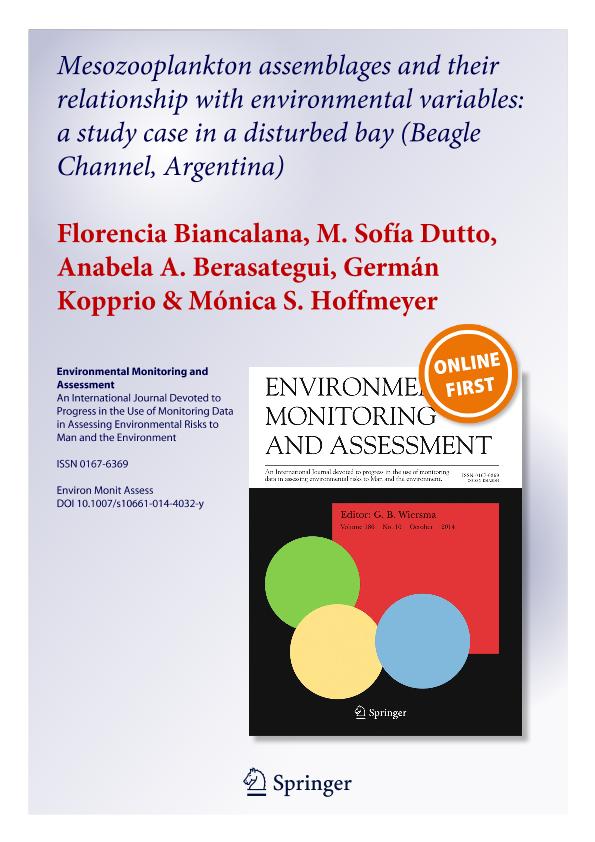Artículo
Mesozooplankton assemblages and their relationship with environmental variables: a study case in a disturbed bay (Beagle Channel, Argentina)
Biancalana, Florencia ; Dutto, María Sofía
; Dutto, María Sofía ; Berasategui, Anabela Anhi
; Berasategui, Anabela Anhi ; Kopprio, Germán Adolfo
; Kopprio, Germán Adolfo ; Hoffmeyer, Monica Susana
; Hoffmeyer, Monica Susana
 ; Dutto, María Sofía
; Dutto, María Sofía ; Berasategui, Anabela Anhi
; Berasategui, Anabela Anhi ; Kopprio, Germán Adolfo
; Kopprio, Germán Adolfo ; Hoffmeyer, Monica Susana
; Hoffmeyer, Monica Susana
Fecha de publicación:
09/2014
Editorial:
Springer
Revista:
Environmental Monitoring And Assessment
ISSN:
0167-6369
Idioma:
Inglés
Tipo de recurso:
Artículo publicado
Clasificación temática:
Resumen
This study focused on the seasonal and spatial analysis of the mesozooplankton community in a human-impacted subantarctic bay in Argentina and aimed to detect assemblages associated with environmental variability. Mesozooplankton samples and environmental data were obtained in the Ushuaia Bay (UB) seasonally, from August 2004 to June 2005, and spatially, from coastal (more polluted), middle (less influenced) and open sea water (free polluted) sampling stations. Remarkable seasonal changes on the mesozooplankton community were observed. Nitrogenated nutrients, chlorophyll a, salinity and temperature were the prevailing environmental conditions likely associated with the different mesozooplankton assemblages found in the bay. The copepods Eurytemora americana, Acartia tonsa, Podon leuckarti and Nematoda were particularly observed on the northwest coast of the bay, characterized by the highest level of urban pollution, eutrophicated by sewage and freshwater inputs from the Encerrada Bay which is connected to it. The stations situated in the northeast area, mostly influenced by freshwater input from rivers and glacier melting, showed low mesozooplankton abundances and an important contribution of adventitious plankton. The copepods Ctenocalanus citer, Clausocalanus brevipes and Drepanopus forcipatus were mostly observed at the stations located near the Beagle Channel, characterized by open sea and free polluted waters. Our findings suggest that the variations observed in the mesozooplankton assemblages in the UB seem to be modulated by environmental variables associated with the anthropogenic influence, clearly detected on the coast of the bay. Certain opportunistic species such as A. tonsa and E. americana could be postulated as potential bioindicators of water quality in subantarctic coastal ecosystems.
Archivos asociados
Licencia
Identificadores
Colecciones
Articulos(IADO)
Articulos de INST.ARG.DE OCEANOGRAFIA (I)
Articulos de INST.ARG.DE OCEANOGRAFIA (I)
Citación
Biancalana, Florencia; Dutto, María Sofía; Berasategui, Anabela Anhi; Kopprio, Germán Adolfo; Hoffmeyer, Monica Susana; Mesozooplankton assemblages and their relationship with environmental variables: a study case in a disturbed bay (Beagle Channel, Argentina); Springer; Environmental Monitoring And Assessment; 186; 12; 9-2014; 8629-8647
Compartir
Altmétricas



